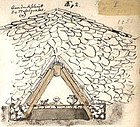Dieskau burial mound
Coordinates: 51 ° 25 ′ 34.7 " N , 12 ° 2 ′ 11.8" E
| Dieskau burial mound | ||
|---|---|---|
|
|
||
| When | 2300-1550 BC BC, Early Bronze Age | |
| Where | Kabelsketal , OT Dieskau in Saxony-Anhalt , Germany | |
The burial mound of Dieskau was a burial mound of the Early Bronze Age Aunjetitz culture (2300–1550 BC) near Dieskau , a district of the municipality of Kabelsketal in the Saale district ( Saxony-Anhalt ). In the run-up to construction work, an emergency excavation was carried out in 1979 under the direction of Berthold Schmidt and Waldemar Nitzschke , during which the remains of the hill were explored.
location
The hill lay in a field south of Dieskau and east of the castle park . The remains of several other burial mounds were found in the area. These include the Bornhöck near Raßnitz , which was removed in the 19th century and the remains of which were archaeologically examined between 2014 and 2017, and the Hallberg between Benndorf and Osmünde .
The area around Dieskau was one of the economic and political centers of the Aunjetitz culture. This is indicated by the neighboring Bornhöck, which, with a diameter of 65 meters and a height of presumably 15 meters, is one of the largest Bronze Age burial mounds in Central Europe . There are also two important archaeological finds with bronze objects ( Dieskau II and III ). Another ensemble of gold objects ( Dieskau I ) was originally seen as another depository find.
description
The hill was on a hill about 60 m in diameter and 2 m high. The actual burial mound had a diameter of almost 30 m. Its original height is estimated to be around 6 m. In the center was a burial chamber . It was oriented approximately north-south with a deviation of 16 ° to the west. Their length was 4.26 m and their width 3.34 m. The chamber was looted and badly damaged, but enough remains were left to reconstruct its original appearance. Foundation pits were found on all four sides. They sloped inwards on the long sides and originally served to accommodate a roof structure made of wooden planks placed at an angle. The southern narrow side also had a slightly sloping pit, while the northern one was vertical. Presumably the entrance to the chamber was also on the north side. Quarry stones of different sizes on the outside of the pits were used to wedge the wooden planks. Other quarry stones came from a stone mantle that had once enclosed the burial chamber.
Both in its size and the structure of the burial chamber, the hill of Dieskau resembles the prince grave of Leubingen ( Sömmerda district , Thuringia ) and the prince grave of Helmsdorf ( Mansfeld-Südharz district , Saxony-Anhalt). It can therefore be assumed that a person of equally high social standing was buried here. Grave goods were not found during the emergency recovery. The hypothetical assignment of the gold finds from Dieskau to this hill by Schmidt and Nitzschke is now obsolete.
literature
- Juliane Filipp, Martin Freudenreich: The early Bronze Age wealth in the microregion around Halle-Dieskau - visit to the excavation of the »Bornhöck« as well as other early Bronze Age sites. In: Archeology in Saxony-Anhalt. NF Volume 9, 2018, pp. 377-380 ( online ).
- Berthold Schmidt , Waldemar Nitzschke : An early Bronze Age "prince hill" near Dieskau in the Saale district. Preliminary report. In: excavations and finds. Volume 25, 1980, pp. 179-183.
- Andreas Sattler : The graves of the Aunjetitz culture in the Saale region. On the ritual of the dead based on the older findings (= university research on prehistoric archeology. Volume 267). Habelt, Bonn 2015, ISBN 978-3-7749-3941-7 , pp. 97-98.


